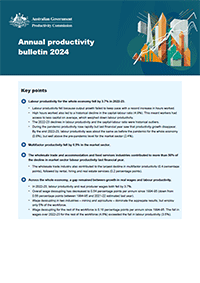Annual productivity bulletin 2024

PC productivity insights
Released 29 / 02 / 2024
The Bulletin unpacks the latest Australian Bureau of Statistics (ABS) annual productivity statistics and examines trends and new developments underlying Australia's productivity performance.
Productivity fell in 2022-23 as record high increases in hours worked outpaced output growth.
New insights into Australia’s productivity problem
A new report from the Productivity Commission shows that labour productivity fell sharply in 2022-23, as a record-breaking increase in hours worked failed to generate a similar increase in economic output.
The Annual productivity bulletin 2024 provides the most complete picture to-date of the drivers of Australia’s productivity decline over 2022-23.
“We now have a clearer understanding of what’s behind Australia’s productivity slump. Sharp increases in working hours have seen productivity decline, but this makes policies to boost productivity even more important," said Productivity Commission Deputy Chair Alex Robson.
Labour productivity fell by 3.7% – well below the long-term average growth rate of 1.3%. This result was driven by a 6.9% increase in hours worked by Australians – the highest annual increase in history.
The decline in labour productivity was accompanied by slow hourly wage growth over the year. Despite this, average incomes increased.
“Australians’ incomes grew in 2022-23, mostly because they worked more hours. But productivity growth is about working smarter, not working harder or longer. Given our labour force participation rate is near its historical high, we won’t be able to rely on working harder or longer as a source of income growth moving forward,” said Deputy Chair Robson.
“What’s worse, we know nominal wage growth without productivity growth can fuel inflation. Sustainable, long-term wage growth can only be realised by securing productivity gains.”
The capital-to-labour ratio fell by 4.9% in 2022-23 – the highest recorded decline in Australia’s history. This meant on average, each worker had access to a shrinking amount of capital, which weighed down labour productivity.
“Employment growth easily outpaced capital deepening in 2022-23. So while a record number of Australians had jobs, employers didn’t invest in the equipment, tools and resources that are needed to make the most of employees’ skills and talents. Further capital investment would help turn our strong employment growth into strong productivity growth,” said Deputy Chair Robson.
The decline in labour productivity over 2022-23 reversed the gains seen during the earlier stages of the COVID-19 pandemic.
“Measured productivity rose rapidly during COVID-19, mostly due to a temporary sectoral shift in employment, away from low productivity industries to higher productivity industries. This data shows that this pandemic ‘productivity bubble’ has well and truly burst,” said Deputy Chair Robson.
The report also found that wage decoupling – the extent to which productivity growth fails to drive growth in real wages – was slightly higher than previously thought for most Australians, partly due to revisions in the Australian Bureau of Statistics historical data.
“The relationship between wages and productivity weakened slightly, but it is still strong over the long run. This reminds us that productivity growth is still the only path to sustainable growth in real wages over time,” said Deputy Chair Robson.
When released, this publication can be accessed from the Commission’s website at www.pc.gov.au
Media requests
Media team – 02 6240 3330 / media@pc.gov.au
- Labour productivity for the whole economy fell by 3.7% in 2022-23.
- Labour productivity fell because output growth failed to keep pace with a record increase in hours worked.
- High hours worked also led to a historical decline in the capital-labour ratio (4.9%). This meant workers had access to less capital on average, which weighed down labour productivity.
- The 2022-23 declines in labour productivity and the capital-labour ratio were historical outliers.
- During the pandemic productivity rose rapidly but last financial year saw that productivity growth disappear. By the end 2022-23, labour productivity was about the same as before the pandemic for the whole economy (0.8%), but well above the pre-pandemic level for the market sector (2.4%).
- Multifactor productivity fell by 0.5% in the market sector.
- The wholesale trade and accommodation and food services industries contributed to more than 50% of the decline in market sector labour productivity last financial year.
- The wholesale trade industry also contributed to the largest decline in multifactor productivity (0.4 percentage points), followed by rental, hiring and real estate services (0.2 percentage points).
- Across the whole economy, a gap remained between growth in real wages and labour productivity.
- In 2022-23, labour productivity and real producer wages both fell by 3.7%
- Overall wage decoupling has decreased to 0.54 percentage points per annum since 1994-95 (down from 0.56 percentage points between 1994-95 and 2021-22).
- Wage decoupling in two industries – mining and agriculture – dominate the aggregate results, but employ only 5% of the workforce.
- Wage decoupling for the rest of the workforce is 0.18 percentage points per annum since 1994-95. The fall in wages over 2022-23 for the rest of the workforce (4.6%) exceeded the fall in labour productivity (3.5%).
Media requests
Media team – 02 6240 3330 / media@pc.gov.au
Key points
- Whole of economy growth and productivity
- Industry-level productivity
- Wage decoupling – an update
References
Copyright and publication detail
Appendix
We value your comments about this publication and encourage you to provide feedback.


